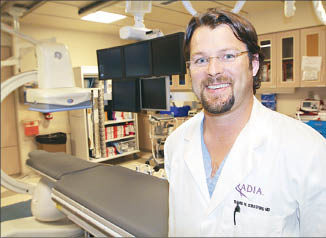
Home » Injecting cement into spine meant to help osteoporosis sufferers
Injecting cement into spine meant to help osteoporosis sufferers
Physician says alternative to invasive back surgery eases pain

September 27, 2012
A minimally invasive procedure to repair vertebrae fractures common in osteoporosis sufferers has become slightly less invasive at Valley Hospital.
Called vertebroplasty, the procedure involves injecting a special bone cement into compression fractures in a vertebra to prevent the bone from collapsing. A similar procedure called kyphoplasty involves inserting a small, deflated balloon into the fractured bone, expanding the balloon to create a cavity, then filling the cavity with the cement.
Interventional radiologist Dr. Travis Stratford says Valley Hospital added a fluoroscopy suite earlier this year that enables physicians conducting the procedure to see a patient's vertebrae from multiple angles. Also, the procedure previously involved making two incisions into a patient's back, and the procedure now is handled with a single 4-millimeter incision there, says Stratford, who is employed by Radia Inc., a Seattle-based radiology practice with which Valley and Deaconess hospitals contract for radiology services.
Stratford says the vast majority of the patients who suffer the types of fractures treated with vertebroplasty and kyphoplasty have osteoporosis, a disease in which a person loses bone density, causing the bones to become more brittle. Most of those patients are seniors, 65 years old or older. Stratford says that while research suggests that 80 percent of osteoporosis sufferers are women, he sees an even mix of men and women in need of this particular procedure.
The procedure itself is outpatient surgery for which either a general anesthetic or a conscious sedation is used. Stratford says fluoroscopic X-ray imaging allows a physician to see the fractured vertebra, which usually is in either the thoracic or the lumbar region—middle or lower—region of the spine, and a patient is in surgery for about an hour per fractured vertebra. The cement is injected in a liquid form and solidifies quickly, becoming rocklike in hardness.
Within a couple of days, a patient usually will have a range in motion similar to what they had before the fracture, Stratford says.
In addition to restored mobility, he says, "Most patients report significant pain improvement."
The procedure is an alternative to invasive surgical procedures, which Stratford says are necessary in some instances. For example, a patient will require surgery if a fracture causes a bone to impinge on a nerve. Also, he says, surgery is required to address more complex fractures, such as a burst fracture that causes multiple breaks in a bone.
A patient can break bones by falling or having some other sort of accident, but for osteoporosis sufferers, simple movements, such as reaching down to pick up an item or twisting their torso while sitting, can cause a fracture, Stratford says. In some cases, patients might not realize they have suffered fractures, but only know they're suffering increased back pain.
Osteoporosis patients that incur one fracture are much more likely to sustain additional fractures, Stratford says. Research, he says, suggests that the likelihood of additional fractures becomes five times more likely.
If such fractures are left untreated, Stratford says, the vertebra can collapse, causing a decrease in height and possibly making it so one can no longer stand up straight and is continuously hunched over.
Other causes for spinal compression fractures include bone cancer, also known as bone mastitis, and benign bone tumors. That latter, known as hemangioma, doesn't come up that often, Stratford says.
The procedure typically isn't used in post-traumatic treatment of younger people who suffer compression fractures. Generally, a younger person's bones will heal on their own without the procedure, he says.
Stratford is one of three interventional radiologists employed by Radia who work at Valley and Deaconess hospitals. Based in Everett, Wash., the company employs more than 80 board-certified radiologists who work at more than 30 hospitals and specialty clinics.
Valley and Deaconess, along with Spokane-based Rockwood Clinic, are owned by Community Health Systems, the big, for-profit hospital and medical clinic operator based in Brentwood, Tenn.
Latest News
Related Articles




